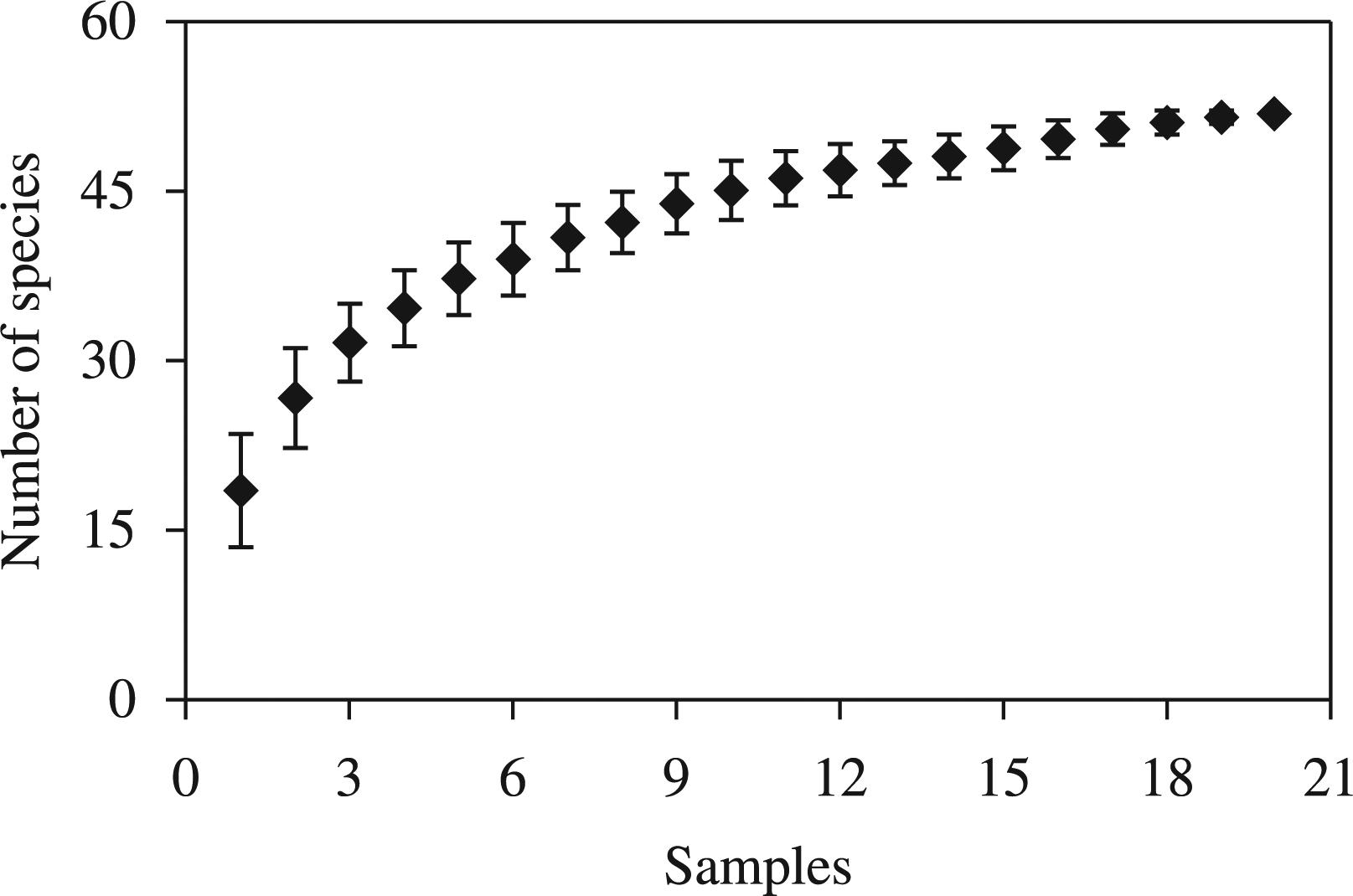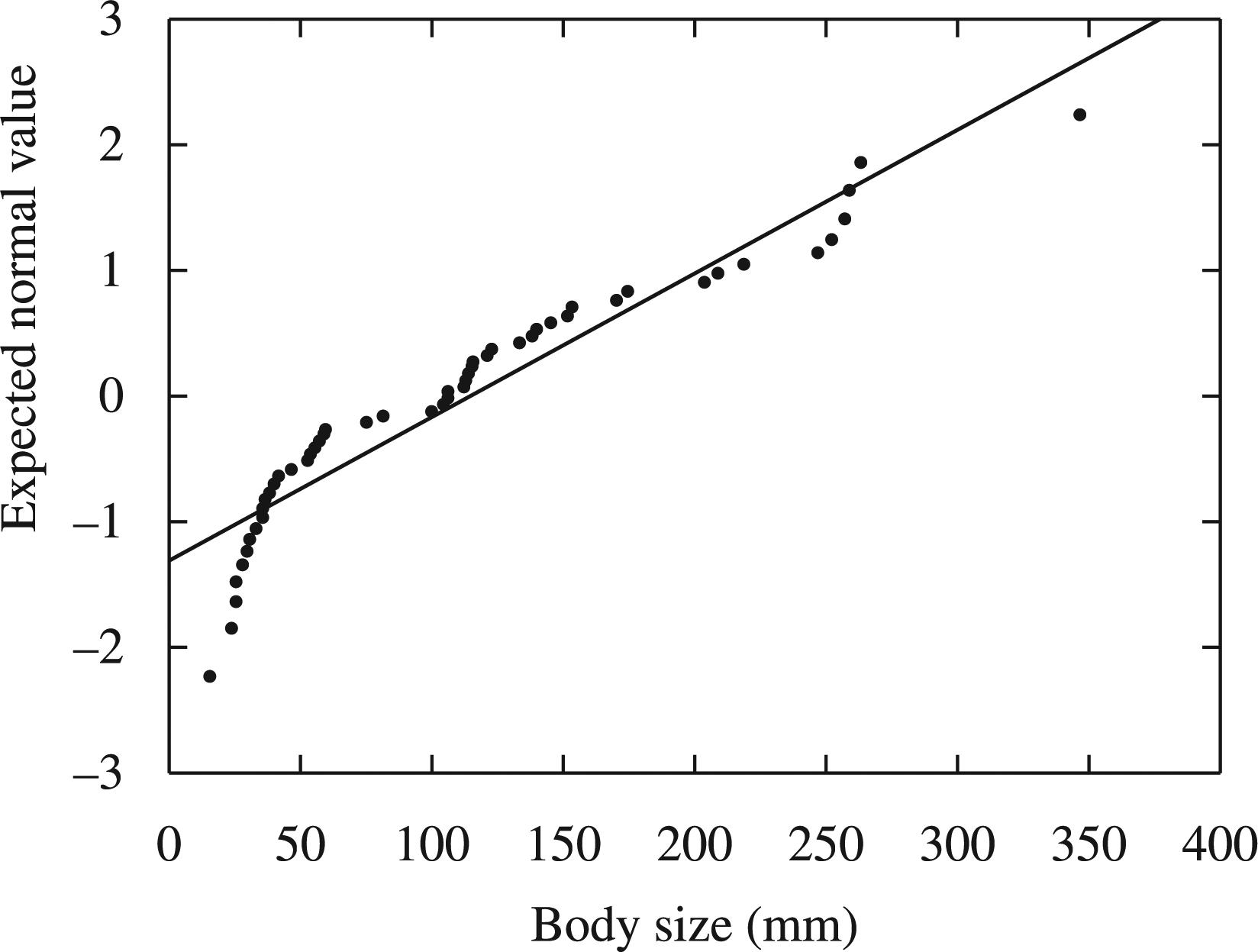|
Characiformes
|
|
Parodontidae
|
|
Apareiodon piracicabae (Eigenmann, 1907) |
3 |
|
36.1-81.7 |
|
35.5 |
51.1 |
26.5 |
|
Parodon nasus Kner, 1859 |
23 |
76.9-113.6 |
87.1 |
|
36.8 |
88.2 |
16.4 |
|
Curimatidae
|
|
Cyphocharax modestus (Fernández-Yépez, 1948) |
48 |
93.7-117.7 |
75.1-113.3 |
98.5 |
75.1-121.9 |
102.2 |
9.9 |
|
Steindachnerina insculpta (Fernández-Yépez, 1948) |
136 |
74.0-104.2 |
73.4-115.0 |
86.0-96.7 |
39.7-109.2 |
90.3 |
10.5 |
|
Prochilodontidae
|
|
Prochilodus lineatus (Valenciennes, 1836) |
10 |
137.2-248.0 |
237.0 |
217.0-257.0 |
|
232.1 |
35.2 |
|
Anostomidae
|
|
Leporinus aff. friderici (Bloch, 1794) |
3 |
|
127.1 |
140.2 |
139.9 |
135.7 |
7.5 |
|
Leporinus octofasciatus Steindachner, 1915 |
6 |
158.3 |
163.3 |
136.9 |
140.7-219.0 |
163.0 |
29.5 |
|
Leporinus striatus Kner, 1858 |
36 |
102.5-110.9 |
102.6-110.9 |
101.5-111.7 |
97.3-110.9 |
105.7 |
4.0 |
|
Schizodon nasutus Kner, 1858 |
4 |
194.5-219.0 |
|
|
|
215.9 |
23.1 |
|
Crenuchidae
|
|
Characidium aff. zebra Eigenmann, 1909 |
10 |
47.6-59.1 |
37.9-57.0 |
|
33.2 |
45.3 |
8.9 |
|
Characidae
|
|
Astyanax altiparanae Garutti & Britski, 2000 |
144 |
26.9-101-7 |
31.1-96.7 |
17.4-100.1 |
65.7-106.5 |
78.6 |
15.0 |
|
Astyanax fasciatus (Cuvier, 1819) |
239 |
64.4-113.8 |
11.4-115.9 |
43.0-106.8 |
18.5-111.4 |
79.9 |
20.6 |
|
Astyanax bockmanni Vari & Castro, 2007 |
3 |
65.7-75.4 |
|
|
31.8 |
52.5 |
18.2 |
|
Bryconamericus cf. iheringii (Boulenger, 1887) |
218 |
29.6-43.5 |
19.7-51.1 |
20.0-39.9 |
15.1-52.8 |
29.8 |
6.3 |
|
Cheirodon stenodon Eigenmann, 1915 |
226 |
14.1-29.1 |
15.5-31.8 |
14.1-33.5 |
14.6-31.8 |
22.9 |
5.1 |
|
Hemigrammus marginatus Ellis, 1911 |
147 |
16.8-31.0 |
12.8-25.3 |
18.7-24.4 |
13.2-27.5 |
23.0 |
3.7 |
|
Hyphessobrycon anisitsi (Eigenmann, 1907) |
3 |
19.4-25.5 |
|
|
|
22.1 |
3.1 |
|
Piabina argentea Reinhardt, 1867 |
486 |
34.9-51.8 |
17.5-54.1 |
20.7-52.9 |
14.3-50.7 |
36.6 |
9.0 |
|
Planaltina britskii Menezes, Weitzman & Burns, 2003 |
67 |
21.2-37.0 |
33.9-37.1 |
29.3 |
|
29.3 |
5.6 |
|
Salminus hilarii Valenciennes, 1850 |
10 |
194.2 |
163.5-231.0 |
229.0-242.0 |
157.6 |
219.6 |
35.4 |
|
Serrapinnus heterodon (Eigenmann, 1915) |
2 |
29.5-35.6 |
|
|
|
32.6 |
4.3 |
|
Serrapinnus notomelas (Eigenmann, 1915) |
68 |
15.3-30.3 |
13.2-24.4 |
15.5 |
15.0-24.3 |
20.1 |
4.2 |
|
Serrasalmus maculatus Kner, 1858 |
1 |
104.2 |
|
|
|
104.2 |
- |
|
Acestrorhynchidae
|
|
Acestrorhynchus lacustris (Lütken, 1875) |
46 |
65.5-184.3 |
123.4-185.5 |
117.1-209.0 |
120.8-203.8 |
148.2 |
29.4 |
|
Erythrinidae
|
|
Hoplias aff. malabaricus (Bloch, 1794) |
5 |
183.6-252.0 |
208.1 |
11.1-98.7 |
|
150.7 |
96.0 |
|
Siluriformes
|
|
Aspredinidae
|
|
Bunocephalus larai Ihering, 1930 |
2 |
55.4-59.8 |
|
|
|
57.6 |
3.1 |
|
Trichomycteridae
|
|
Paravandellia oxyptera Miranda Ribeiro, 1912 |
12 |
23.2 |
18.6-21.3 |
20.6 |
23.7 |
19.7 |
2.9 |
|
Callichthyidae
|
|
Corydoras aeneus (Gill, 1858) |
40 |
35.1-46.6 |
35.1-46.6 |
|
35.4-41.7 |
39.7 |
3.4 |
|
Corydoras flaveolus Ihering, 1911 |
78 |
30.6-32.5 |
26.4-37.6 |
18.8-37.4 |
18.2-40.1 |
32.2 |
4.4 |
|
Hoplosternum littorale (Hancock, 1828) |
1 |
170.7 |
|
|
|
170.7 |
- |
|
Loricariidae
|
|
Rineloricaria latirostris (Boulenger, 1900) |
38 |
96.4-122.6 |
47.0-128.5 |
26.0-115.3 |
31.7-145.2 |
84.4 |
34.3 |
|
Hypostomus ancistroides (Ihering, 1911) |
143 |
30.8-126.4 |
29.2-143.8 |
20.6-159.6 |
37.1-164.1 |
90.1 |
35.0 |
|
Hypostomus regani (Ihering, 1905) |
22 |
61.9-103.4 |
54.8-152.0 |
92.0 |
122.9 |
88.7 |
24.6 |
|
Hypostomus strigaticeps (Regan, 1908) |
183 |
51.9-137.5 |
71.0-124.7 |
88.2-153.6 |
81.2-133.3 |
90.2 |
18.7 |
|
Hypostomus hermanni (Ihering, 1905) |
45 |
47.6-130.5 |
90.1-133.4 |
138.4-138.8 |
|
92.7 |
22.6 |
|
Hypostomus sp. |
132 |
45.4-100.2 |
17.6-106.5 |
26.2-82.9 |
65.8-87.9 |
72.6 |
17.5 |
|
Hisonotus depressicauda (Miranda-Ribeiro, 1918) |
48 |
20.6-38.3 |
32.3 |
20.8-35.3 |
21.4-30.0 |
30.4 |
4.8 |
|
Pseudopimelodidae
|
|
Microglanis garavelloi Shibatta & Benine, 2005 |
4 |
|
35.6-41.9 |
34.1 |
|
36.9 |
3.5 |
|
Pseudopimelodus mangurus (Valenciennes, 1835) |
1 |
|
|
204.1 |
|
204.1 |
- |
|
Heptapteridae
|
|
Imparfinis schubarti (Gomes, 1956) |
12 |
66.4-99.8 |
|
|
|
86.2 |
9.5 |
|
Imparfinis mirini Haseman, 1911 |
2 |
|
|
54.3 |
48.2 |
51.3 |
4.3 |
|
Pimelodella cf. meeki Eigenmann, 1910 |
10 |
42.4-106.6 |
91.9-102.6 |
56.9 |
|
87.5 |
22.2 |
|
Rhamdia quelen (Quoy & Gaimard, 1824) |
9 |
144.1 |
142.8 |
134.1 |
159.0-264.0 |
143.4 |
57.7 |
|
Auchenipteridae
|
|
Tatia neivai (Ihering, 1930) |
1 |
|
|
|
36.0 |
36.0 |
- |
|
Gymnotiformes
|
|
Gymnotidae
|
|
Gymnotus aff. carapo Linnaeus, 1758 |
10 |
170.0-347.0 |
|
38.3-123.0 |
|
177.8 |
89.7 |
|
Sternopygidae
|
|
Eigenmannia aff. virescens (Valenciennes, 1842) |
5 |
84.6-147.0 |
|
|
259.0 |
151.2 |
64.7 |
|
Cyprinodontiformes
|
|
Poeciliidae
|
|
Phalloceros harpagos Lucinda, 2008 |
52 |
|
15.0-18.2 |
23.0 |
10.0-28.4 |
18.8 |
5.0 |
|
Poecilia reticulata Peters, 1859 |
1 |
16.1 |
|
|
|
16.1 |
- |
|
Poecilia vivipara Bloch & Schneider, 1801 |
1 |
25.4 |
|
|
|
25.4 |
- |
|
Synbranchiformes
|
|
Synbranchidae
|
|
Synbranchus marmoratus Bloch, 1795 |
3 |
|
123.2 |
|
|
117.8 |
7.6 |
|
Perciformes
|
|
Cichlidae
|
|
Australoheros sp. |
1 |
|
57.0 |
|
|
57.0 |
- |
|
Geophagus brasiliensis (Quoy & Gaimard, 1824) |
71 |
17.9-133.6 |
14.2-109.1 |
26.1-37.7 |
21.2-98.7 |
64.9 |
32.8 |
| N |
2871 |
|
|
|
|
|
|
| Total of species |
52 |
43 |
37 |
34 |
33 |
|
|




